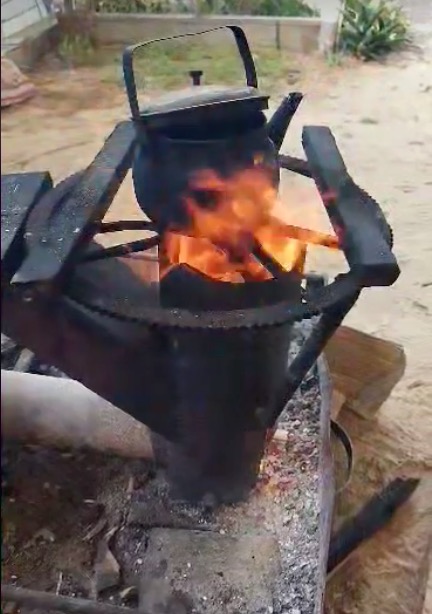Engineering a kitchen in Gaza

On the fourth day of the war, our community faced a dire challenge: a complete loss of electricity. When my family’s kitchen gas ran out too, we felt a complete sense of helplessness, even as we received an influx of evacuated families into our home. To overcome this feeling, I embarked on several engineering projects that have empowered me and helped me rediscover a sense of purpose.
Clay oven
I wanted to help my mother feed the people staying in our home, plus our own family, which numbers 11. So I designed a clay oven, like the traditional ovens Gazans used to cook bread.
I found an old iron drum among my father’s piles of stuff — he never gets rid of anything. Then I obtained clay from a piece of land next to my house in eastern Rafah, which was bombed (I moved back to the family home because of this bombing). Not every type of clay works for building ovens, but this clay was the right kind.
I used cement to piece together a large stone slab that matched the drum’s circumference, then placed the drum on top of it. I laid another stone slab midway inside the drum, to create the floor for baking, and then lined the interior with the clay. I also cut an opening at the base of the drum. This created a space for laying the wood that will burn to create the heat that bakes the bread. Finally, I added another slab to create the roof. My mother has been able to use this oven to sustain all the families we are hosting.


Inside-out stove
One week later, I was pondering how to create an oven that could use other sources of fuel besides wood. I brainstormed with my father, and we came up with an innovation that my father declared was “brilliant.” We used another drum and engineered it so that the combustible materials go inside. Oil can be poured inside by an exterior tap. The bread is laid on top, like cakes on a griddle, and a pipe carries the smoke outdoors, leaving the taste of the bread unaffected.
This innovative stove quickly gained popularity among neighbors because it can use various types of fuel, not just wood, which is scarce.


Water heater
Anther problem I worked to solve was heating water. I solved this problem two ways.
The first solution is straightforward. I took a large metal pipe and arranged a burner on top where a kettle can be placed. Fuel such as pieces of wood can be inserted through an attached horizontal feed pipe or by being dropped in from the top. The pipe makes a contained fire that efficiently heats the water inside the kettle.

My second water heating system is even more innovative. I purchased a large plastic water container and linked it with plastic tubing to copper tubing, which I laid in a spiral inside my stove described above. Gravity allows the water to flow through the plastic tubing into the copper tubing. The water heats as it passes through and then flows into an empty bucket. The concept is like that of an electric heater.
I have found genuine happiness witnessing the widespread use of my kitchen appliances, not only by my mother but by other families that have evacuated from Gaza City and the north. My focus is on the comfort of others, working intentionally for their well-being, even though it has required a lot of hard work.

This story was first published by We Are Not Numbers, on January 9th 2024. It was written by Abdallah al-Jazzar, as a personal narrative from under the relentless bombardment of Gaza by Israel.
